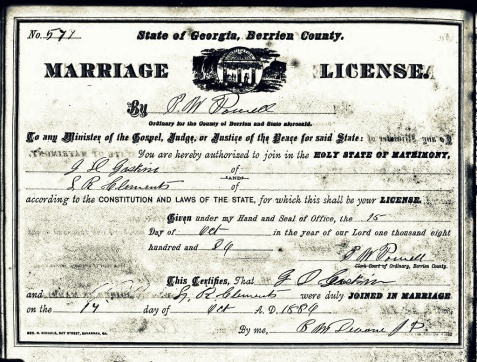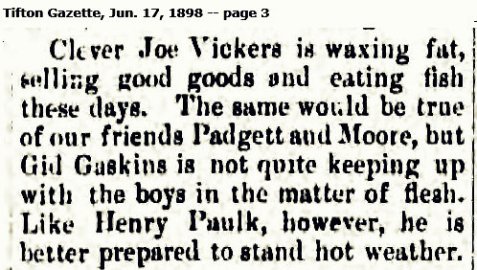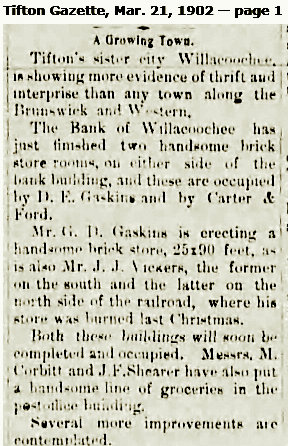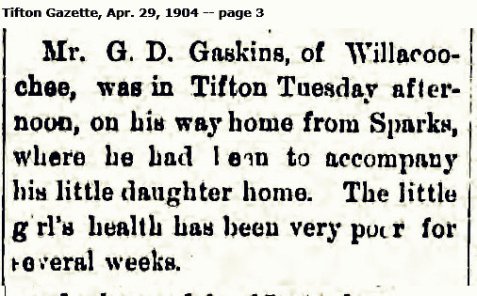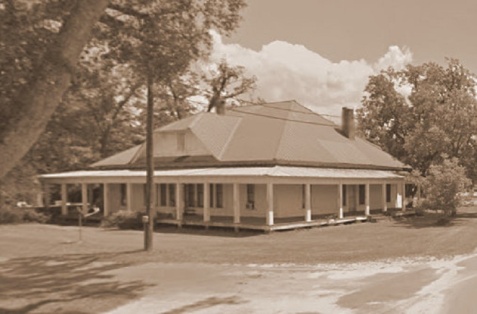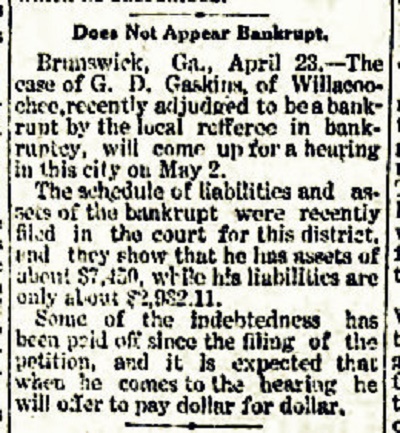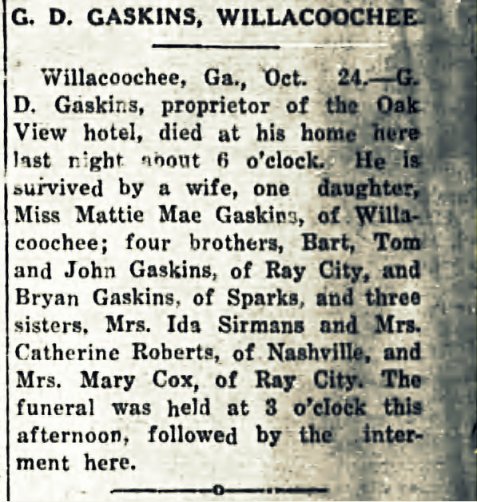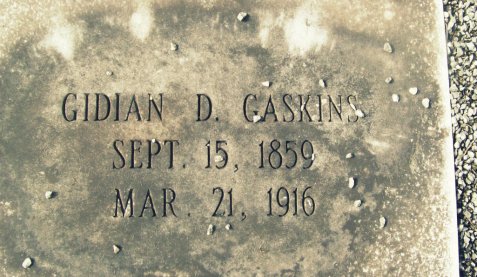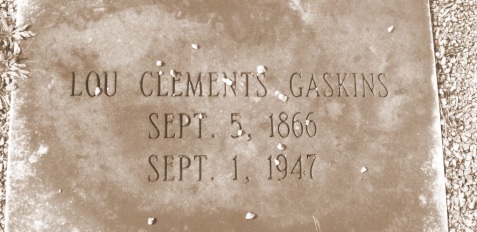Charles Bruner Shaw (1888-1950)
Special thanks to Bryan Shaw for sharing photos and content for this post. Portions reprinted from Shaw Family Newsletter: Charles Bruner Shaw
Born in 1888 in a corn crib on the John Allen farm just outside Ray City, GA, Bruner Shaw would later serve as a police officer for the town. He was a son of Francis Arthur Shaw and Victoria Giddens Knight.
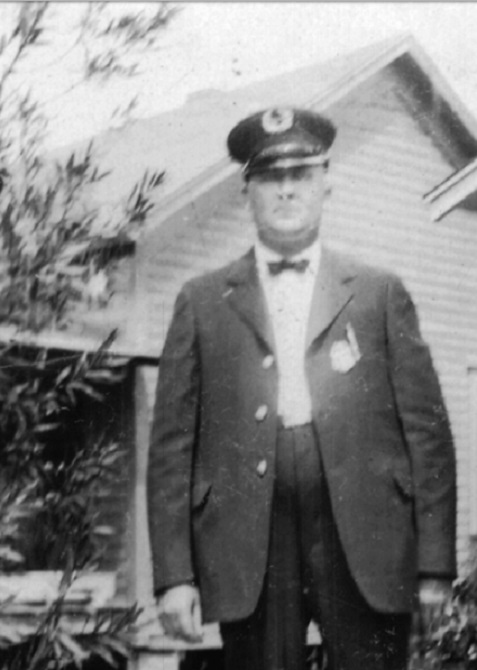
Bruner Shaw in police uniform about 1926. Photographed in Florida. Image courtesy of Bryan Shaw.
After Bruner’s mother died of scarlet fever in 1889, he and his brother Brodie Shaw were raised by their grandparents, Francis Marion Shaw and Rachel Moore Allen Shaw. The home place of Francis Marion Shaw and Rachel Moore Allen Shaw was just west of Ray City, at Lois, GA just off Possum Branch Road. Bruner attended school through the eighth grade at the two-room Pine Grove School. The Pine Grove and Kings Chapel schools were filled at various times with the children, grandchildren, and great grandchildren of Rachel and Francis Marion Shaw.

Bruner Shaw circa 1905
At a young age, Bruner Shaw married Mollie Register, daughter of William M. Register (1852-1926) and Sarah Laura Parrish Register (1854-1933), and granddaughter of Elder Ancil Parrish, the old Primitive Baptist preacher of Berrien County. The Registers were a prominent family of Nashville, GA. Bruner and Mollie were married on New Year’s Eve, December 31, 1905, in a ceremony performed by Bruner’s uncle Aaron Anderson Knight, of Ray City, GA. Reverend Knight was then primitive Baptist minister of Pleasant Church, just west of Ray City, GA. The bride was one month shy of her 20th birthday; the groom had just turned 17.

Marriage certificate of Charles Bruner Shaw and Mollie Register, December 31, 1905.
Bruner farmed for a while at Ray City, GA near his brother, Brodie Shaw. The census of 1910 shows other neighbors included Mack Speights, Joseph S. Clements, Bryant Fender, and Frank Gallagher.
A Year of Tragedy
In January 1911, when his aunt and uncle, Eliza Allen and Sovin J. Knight, moved to Brooks County to a farm on the Little River near Barney, GA, Bruner went along, moving his young family to an adjacent farm. But shortly after their move to Barney, “on April 16, 1911, just 26 days after the purchase of the new farm, Sovin suffered a severe heart attack and died in his new home.
After this family loss coupled with the death of his infant daughter, Pecola, Bruner Shaw sold his Brooks County farm and returned to Berrien County. Just six weeks after the sale, his wife, Mollie Register Shaw, died of Scarlet Fever. She was buried at Pleasant Cemetery, near Ray City, GA.
Bruner’s widowed aunt Eliza later moved her daughters, Kathleen and Rachel, back to Berrien County to live in the farm home of her parents (Bruner’s grandparents), Rachel Moore Allen Shaw and Francis Marion Shaw, just outside of Ray City, GA.

Grave of Mollie Register Shaw (1886-1911), Pleasant Cemetery, near Ray City, GA. Image source: Cat
The young widower soon enlisted the help of a teen-age girl to help take care of his children. Fifteen-year-old Charlie Ruth Griffin was the youngest child of William Harrison “Hass” Griffin and Rebecca Jane Parrish, born June 25, 1897 in her family’s cabin on South Old Coffee Road in Berrien County. Her siblings were Sarah Rebecca, Georgia Lavinia, Mary Ellen, Margaret Frances “Fannie”, Willie Henrietta, William Franklin, and Robert Bruce Griffin.
As Charlie took care of Bruner’s children, they grew very close to their nursemaid. After a very brief courtship, Bruner and Charlie were married November 23, 1913, at the home of the Reverend Aaron Anderson Knight in Ray City. Reverend Knight was then serving as the first pastor of the newly organized New Ramah Primitive Baptist Church at Ray City.

Marriage certificate of Charles Bruner Shaw and Charlie Ruth Griffin, November 24, 1913, Ray City, GA
Charlie gave Bruner three more children, Francis Marion Shaw, Lynette Narcissis Shaw, and Charles Bruner Shaw, Jr., and raised Bruner’s two children, Juanita and William Arthur, as if they were her own.
Bruner and Charlie Shaw were a part of society and leisure at Ray City, GA and Berrien County. In February 1914 Bruner was among the people from Ray City attending the carnival at Nashville. Others from Ray City included Annie Mae Carter, Margie Dasher, Pearl Hardie Knight, Mr. and Mrs. G. V. Harvie, W. H. Luckie, George Norton, J. J. and J. S. Clements.
In 1914, Charlie Ruth and her husband, Bruner Shaw, and daughter, Juanita Shaw, were also seen at the Mayhaw Lake Resort on Park Street near Ray City. Mayhaw Lake was “The Place” in Berrien County for more than a decade. It was built in 1914 by Elias Moore “Hun” Knight, of Ray City. The amusement park was such a popular spot that the Georgia & Florida Railroad gave special rates for picnic parties from all points on their line. People from all over the area would journey to Mayhaw Lake, especially on holidays such as the 4th of July and Labor Day. A boarding house [later the home of Effie Guthrie Knight] up the road towards Ray City was opened up by the Paul Knight family specifically to provide lodging for the Mayhaw crowd.

Posing in front of the roller-skating rink at Mayhaw Lake in 1914, left to right: Burton Moore; Tom Parrish; Manson Johnson; unidentified lady; Charlie Ruth Shaw with her husband, Bruner Shaw, and daughter, Juanita Shaw; lady; Viola Smith Davis; lady; Mrs. Burton Moore and daughters, Kate Hazen, Thelma Register; Lonnie Smith; boy; man; Shellie Ziegler; and Jessie Ziegler Touchton. Members of the band in the background include Rossie Swindle, Glenn Johnson, Lonnie Swindle, and J. H. Swindle.
It was about this time that Bruner began his life-long pursuit of the law enforcement profession. Bruner entered police work through occasional employment as a deputy at Ray City. At that time the Police Chief at Ray City was Bruner’s cousin, Cauley Shaw.
An incident report in the Nashville Herald, October 9, 1914:
Considerable excitement was occasioned here Monday by a report that Cauley and Bruner Shaw and two other young men of Ray’s Mill had been shot about twelve miles down the Valdosta Road. Several gentlemen from here [Nashville, GA] went in an automobile. But when they reached the scene, they found that the wounds were not serious. A negro for whom they had a warrant, shot at them with a shotgun loaded with bird shot.
The Tifton Gazette also reported the incident:

Tifton Gazette reports Bruner shot while serving an arrest warrant, October 6, 1914
Tifton Gazette
October 16, 1914
C. B. Shaw, C.H. Jones and Charley Thomas were shot by a negro named John Williams, near Rays Mill Oct. 6, says the Milltown Advocate. Thomas has some trouble with the negro about hauling some cotton and the negro fired at him. He went to Rays Mill, secured a warrant and returned for the negro. The negro opened fire and slightly wounded three of the party who returned from Rays Mill with Thomas. The negro escaped.
Over the next few years, Bruner did stints in the police departments of Milltown (now Lakeland), GA and at Willacoochee. By early 1919, Bruner had been hired by Berrien County Sheriff J. V. Nix as a deputy at Nashville, GA.
Until 1919, most of the activities of a peace officer involved chasing down petty thieves, and raiding an occasional “skins” (gambling) game…
Production and consumption of moonshine – illegal liquor – was also a problem for law officers. State-wide prohibition in Georgia had passed in 1907, with Ray City’s own representative Jonathan Perry Knight among those leading the charge.
However, with the passage of the 18th amendment to the Constitution (prohibition), a whole new illicit business was the target of the county sheriff and his deputies. “Blind tigers”, as they were commonly referred, brewed alcohol in what was known as a “lard can” still, using syrup and meal processed through a copper worm. The product was a high explosive liquor with enough alcohol in it to burn like gasoline. Drinking of such had been known to cause blindness, if not death. Thus, the name “blind tiger.”
By 1919, reports of drunkenness and lawlessness in Ray City were making newspapers throughout the section. There were plenty of “blind tigers” running stills and selling bootleg liquor in Berrien County and Ray City, and gambling, too, despite the efforts of lawmen like Bruner Shaw, Cauley Shaw, Gus Clements, Frank Allen, Marcus Allen, Jim Griner, Wesley Griner, and W.W. Griner.
In April 1919, part-time deputy Bruner Shaw was again shot by an assailant.

1919 Tifton Gazette reports Bruner Shaw shot by John Harris
Tifton Gazette
May 2, 1919
Shaw Shot by Negro
Nashville, Ga., April 23- Bruner Shaw, a well-known young farmer who has served as special deputy sheriff a number of times, was shot from ambush Saturday at the home of Will McSwain, a negro farmer living near Lois, this county. Shaw recognized his assailant as John Harris, a young negro whom he had arrested at Adel several months ago on a misdemeanor charge. The wouldbe murderer used a 23-calibre Winchester rifle, and the bullet entered the left side of Shaw’s head. He was able to come to Nashville today and swear out warrants against the negro, who is in jail here, having been captured by Sheriff Nix.
While pursuing his law enforcement career in other towns, Bruner Shaw maintained his Ray City connections. In 1920 Census records show Bruner and Charlie were residing in Ray City. According to Bryan Shaw, Bruner’s last child, Charles Bruner, Jr., was born on February 6, 1920, in a home on Trixie Street behind the Marion Shaw home in Ray City. Bruner and Charlie resided in the home for three more years, participating regularly in the events of the community, especially dances and song fests.
Nashville Herald
March 15, 1923
News from Ray City—Everybody that wants to laugh as they haven’t since the war, come out on “Dad’s Night” . . . Last but not least will be some very fine singing by several of our gentlemen singers. They alone will be worth your time, should we have no other attraction. Mr. Bruner Shaw has promised us they will give at least four selections.
Later that year, Bruner Shaw was present at the startup of Ray City’s first power plant.
Sometime that fall Bruner, Charlie Ruth, and their five children moved to Polk County, Florida, where Bruner was hired as a deputy. There was steady work tracking down bootleggers and their moonshine stills. Details of big raids appeared in the papers:
The Polk County Recorder
March 2, 1924
“With drawn guns and expecting a battle to the death, sixteen deputies from Sheriff Logan’s force [and two federal agents] surrounded an abandoned sawmill camp in Eastern Polk County. Deputies Hatcher and Shaw volunteered to be a party to call for the surrender of the men sought.”
•∏•
Tampa Tribune
March 31, 1924
Lakeland Deputies Catch Moonshiners
Still of 100-Gallon Capacity Is Haul; Several Arrests Are Made
(Special to the Tribune)
Lakeland, March 30. – Lying in the woods near Bowling Green, Deputies [Newt] Hatcher and Shaw of the sheriff’s office Friday night watched a suspected bootlegger uncover two gallons of moonshine near the hiding place. Floyd Douglas, it is alleged, was getting the liquor to sell to Federal Officer Standau, unaware of the officer’s identity. Five gallons more were found in a search, and Douglas and the liquor were taken into custody. This is said to be Douglas’ second offense.
Just before the Bowling Green visit, the three officials made a big haul at Mulberry, where a 100-gallon copper still, 18 barrels of mash and six gallons of ‘shine were found in a swamp a mile from town. A negro man and woman were arrested as operators of the still.
•∏•
The Tampa Times
April 19, 1924
Raids Discourage Makers of ‘Shine
(Special to The Times.)
Bartow, April 19. – When the home of a Mrs. Beaumont, just over the Polk county line in Hillsborough county, was raided Wednesday the officers making the raid captured 244 bottles of 4 1/2 percent beer and three half pint bottles of shine. The arrest was made by Polk county Deputy Sheriffs Hatcher and Shaw with Federal prohibition Officers Standau and Dugan, who took the prisoner and evident to Tampa.
The recent series of captures of “shine” outfits conducted by Sheriff Logan and his deputies seems to have discouraged the moonshining industry in Polk county, according to reports from the sheriff’s office and judging from the record of convictions of violators of the prohibition laws in the criminal court combined with the sentences imposed by Judge Olliphant it seems highly probably that bootleggers of Polk county will decided that business isn’t so good in these parts.
In July 1924 Bruner served as Night Police Chief in Haines City, FL. His friend and colleague, Newt Hatcher, was the Day Police Chief.

Bruner Shaw in front of his squad car at Haines City Florida. Image detail courtesy of Bryan Shaw
The exploits of Officer Shaw were occasionally reported in the Tampa Tribune. On December 21, 1925, the paper reported C. B. Shaw was involved in a gun battle with a murder suspect.

December 21, 1925, C. B. Shaw in gun battle with Odom Dunlap, alleged murderer of Owen Higgins.
Later, Bruner Shaw served as chief of police at Frostproof, FL. A high-profile case while Bruner Shaw as chief of police at Frostproof Florida was the kidnapping of E. L. Mercer, well-to-do citrus grower.

June 6, 1928, Tampa Tribune reports Frostproof, FL police chief Bruner Shaw investigating kidnapping of E.L. Mercer
In the fall of 1929, the Shaw family returned to Berrien County, GA where Bruner sharecropped the John Strickland property on the old Valdosta highway. While the family went about bringing in crops of corn, tobacco and cotton, and the children [Marion, Lynette, and Charles, Jr.] were attending school at Kings Chapel, Bruner found temporary employment with the Berrien County Sheriff and the Ray City Police.
By November 1930 Bruner Shaw was named Chief of Police in Alapaha, GA and moved the family there. He was once again again in pursuit of “blind tigers.”
Nashville Herald,
December 18, 1930
Last Wednesday afternoon Chief C. B. Shaw and Deputy Sheriff Wesley Griner and W. W. Griner went over near Glory and went down in the river swamp about one mile west of Glory and found 180 gallons of corn mash. There was no still found with this buck. The officers poured out the contents and busted up the barrels. The people of Alapaha are pleased with the work of Mr. C. B. Shaw since he has been Chief of Police. We all hope that Mr. Shaw will stay on here as he is doing such good work and helping to clean up the community by catching blind tigers.

Moonshine still bust about 1930 near Glory, GA on the Alapaha River. Chief of Police, Bruner Shaw, 2nd from the right. Other identified is Brooker Shaw, brother of Chief Shaw, 2nd from the left.
It was the midst of the Great Depression, and though his work was appreciated, the pay was meager. In the summer of 1931, Bruner removed his family from Berrien County for last time and the Shaw family moved back to Frostproof.
The Shaw Family Newsletter: CHARLES BRUNER SHAW, SR: Have Badge, Will Travel, by Bryan Shaw, relates the story of Bruner Shaw’s life, law, business, and family.
Related Posts:
































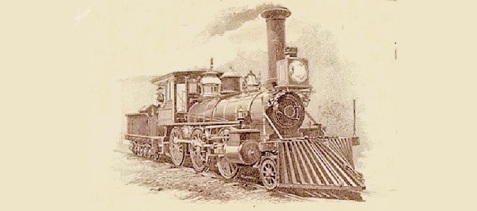

 money. The conductor, knowing that Furlong needed hands, took the negro to Sniff and turned him over to —- was taking to Furlong got off —-Willachoochee,
money. The conductor, knowing that Furlong needed hands, took the negro to Sniff and turned him over to —- was taking to Furlong got off —-Willachoochee,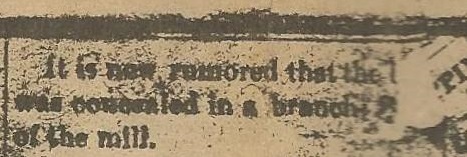 negro at the bridge at Moore’s old mill, but without success.
negro at the bridge at Moore’s old mill, but without success.








